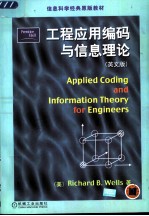图书介绍
工程应用编码与信息理论 英文版【2025|PDF下载-Epub版本|mobi电子书|kindle百度云盘下载】

- (美)Richard B. Wells著 著
- 出版社: 北京:机械工业出版社
- ISBN:711110983X
- 出版时间:2002
- 标注页数:305页
- 文件大小:44MB
- 文件页数:320页
- 主题词:
PDF下载
下载说明
工程应用编码与信息理论 英文版PDF格式电子书版下载
下载的文件为RAR压缩包。需要使用解压软件进行解压得到PDF格式图书。建议使用BT下载工具Free Download Manager进行下载,简称FDM(免费,没有广告,支持多平台)。本站资源全部打包为BT种子。所以需要使用专业的BT下载软件进行下载。如BitComet qBittorrent uTorrent等BT下载工具。迅雷目前由于本站不是热门资源。不推荐使用!后期资源热门了。安装了迅雷也可以迅雷进行下载!
(文件页数 要大于 标注页数,上中下等多册电子书除外)
注意:本站所有压缩包均有解压码: 点击下载压缩包解压工具
图书目录
1.DISCRETESOURCESANDENTROPY1
1.1OverviewofDigitalCommunicationandStorageSystems1
1.2DiscreteInformationSourcesandEntropy 2
1.2.1Sourcealphabetsandentropy,2
1.2.2Jointandconditionalentropy,6
1.2.3Entropyofsymbolblocksandthechainrule,8
1.3SourceCoding10
1.3.1Mappingfunctionsandefficiency,10
1.3.2Mutualinformation,12
1.3.3Abriefdigressiononencryption,14
1.3.4Summaryofsection1.3,15
1.4.1Prefixcodesandinstantaneousdecoding,16
1.4HuffmanCoding16
1.4.2ConstructionofHuffmancodes,17
1.4.3Hardwareimplementationapproaches,19
1.4.4RobustnessofHuffmancodingefficiency,20
1.5DictionaryCodesandLempel-ZivCoding21
1.5.1Therationalebehinddynamicdictionarycoding,21
1.5.2Alinked-listLZalgorithm,22
1.5.3Thedecodingprocess,25
1.5.4Large-blockrequirementofLZcompression,26
1.6ArithmeticCoding28
1.6.1Code-wordlengthandtheasymptoticequipartitionproperty,28
1.6.2Thearithmeticcodingmethod,30
1.6.3Decodingarithmeticcodes,32
1.6.4Otherissuesinarithmeticcoding,33
1.7SourceModelsandAdaptiveSourceCoding34
1.8ChapterSummary35
References36
Exercises37
2.CHANNELSANDCHANNELCAPACITY39
2.1TheDiscreteMemorylessChannelModel39
2.1.1Thetransitionprobabilitymatrix,39
2.1.2Outputentropyandmutualinformation,41
2.2ChannelCapacityandtheBinarySymmetricChannel43
2.2.1Maximizationofmutualinformationandchannelcapacity,43
2.2.2Symmetricchannels,45
2.3.1Equivocation,48
2.3BlockCodingandShannon sSecondTheorem48
2.3.2Entropyrateandthechannel-codingtheorem,49
2.4MarkovProcessesandSourceswithMemory51
2.4.1Markovprocesses,51
2.4.2Steady-stateprobabilityandtheentropyrate,54
2.5MarkovChainsandDataProcessing56
2.6ConstrainedChannels58
2.6.1Modulationtheoryandchannelconstraints,58
2.6.2Linearandtime-invariantchannels,60
2.7AutocorrelationandPowerSpectrumofSequences62
2.7.1Statisticsoftimesequences,62
2.7.2Thepowerspectrum,64
2.8.1Constraintsondatasequences,68
2.8DataTranslationCodes68
2.8.2Statespaceandtrellisdescriptionsofcodes,70
2.8.3Capacityofadatatranslationcode,73
2.9(d,k)Sequences75
2.9.1Run-length-limitedcodesandmaxentropicsequences,75
2.9.2Powerspectrumofmaxentropicsequences,77
2.10ChapterSummary82
References83
Exercises83
3.RUN-LENGTH-LIMITEDCODES89
3.1GeneralConsiderationsforDataTranslationCoding89
3.2PrefixCodesandBlockCodes91
3.2.1Fixed-lengtnblockcodes,91
3.2.2Variable-lengthblockcodes,92
3.2.3PrefixcodesandtheKraftinequality,94
3.3State-DependentFixed-LengthBlockCodes96
3.4Variable-LengthFixed-RateCodes98
3.5Look-AheadCodes102
3.5.1Code-wordconcatenation,102
3.5.2Thekconstraint,104
3.5.3Informalandformaldesignmethods,105
3.6DC-FreeCodes107
3.6.1Therunningdigitalsumandthedigitalsumvariation,107
3.6.2State-splittingandmatchedspectralnullcodes,109
3.7ChapterSummary114
Exercises115
References115
4.LINEARBLOCKERROR-CORRECTINGCODES117
4.1GeneralConsiderations117
4.1.1Channelcodingforerrorcorrection,117
4.1.2Errorratesanderrordistributionforthebinarysymmetricchannel,118
4.1.3Errordetectionandcorrection,121
4.1.4Themaximumlikelihooddecodingprinciple,123
4.1.5Hammingdistancecodecapability,124
4.2BinaryFieldsandBinaryVectorSpaces126
4.2.1Thebinaryfield,126
4.2.2Representinglinearcodesinavectorspace,130
4.3.1Elementarypropertiesofvectorspaces,131
4.3LinearBlockCodes131
4.3.2Hammingweight,Hammingdistance,andtheHammingcube,133
4.3.3TheHammingsphereandboundsonredundancyrequirements,135
4.4DecodingLinearBlockCodes136
4.4.1Completedecodersandbounded-distancedecoders,136
4.4.2Syndromedecodersandtheparity-checktheorem,138
4.5HammingCodes140
4.5.1ThedesignofHammingcodes,140
4.5.2ThedualcodeofaHammingcode,143
4.5.3TheexpandedHammingcode,144
4.6ErrorRatePerformanceBoundsforLinearBlockError-CorrectingCodes147
4.6.1Blockerrorrates,147
4.6.2Biterrorrate,148
4.7PerformanceofBounded-DistanceDecoderswithRepeatRequests149
4.7.1Approximateerrorperformance,152
4.7.2EffectivecoderateofARQsystems,154
4.7.3ARQprotocols,156
4.8ChapterSummary157
References158
Exercises158
5.CYCLICCODES160
5.1DefinitionandPropertiesofCyclicCodes160
5.2PolynomialRepresentationofCyclicCodes162
5.3.1Polynomialrings,164
5.3PolynomialModuloArithmetic164
5.3.2Someimportantalgebraicidentities,166
5.4GenerationandDecodingofCyclicCodes169
5.4.1Generator,parity-check,andsyndromepolynomials,169
5.4.2Systematiccycliccodes,169
5.4.3Hardwareimplementationofencodersforsystematiccycliccodes,171
5.4.4Hardwareimplementationofdecodersforcycliccodes,174
5.4.5TheMeggittdecoder,175
5.5Error-TrappingDecoders178
5.5.1Updatingthesyndromeduringcorrection,178
5.5.2Bursterrorpatternsanderrortrapping,180
5.6SomeStandardCyclicBlockCodes184
5.6.1TheHammingcodes,184
5.6.2BCHcodes,185
5.6.3Burst-correctingcodes,186
5.6.4Cyclicredundancycheckcodes,187
5.7SimpleModificationstoCyclicCodes189
5.7.1Expandingacode,189
5.7.2Shorteningacode,190
5.7.3Noncyclicityofshortenedcodes,193
5.7.4Interleaving,194
5.8ChapterSummary197
References197
Exercises198
6.1DefinitionofConvolutionalCodes201
6.2.1Thestatediagramandtrellisrepresentations,205
6.2StructuralPropertiesofConvolutionalCodes205
6.CONVOLUTIONALCODES207
6.2.2Transferfunctionsofconvolutionalcodes,207
6.3TheViterbiAlgorithm210
6.4WhytheViterbiAlgorithmWorksⅠ:Hard-DecisionDecoding215
6.4.1Maximumlikelihoodunderhard-decisiondecoding,215
6.4.2Erroreventprobability,217
6.4.3Boundsonbiterrorrate,219
6.5SomeKnownGoodConvolutionalCodes221
6.6WhytheViterbiAlgorithmWorksⅡ:Soft-DecisionDecoding223
6.6.1Euclideandistanceandmaximumlikelihood,223
6.6.2Eliminationoftiesandinformationloss,226
6.6.3Calculationofthelikelihoodmetric,228
6.7TheTracebackMethodofViterbiDecoding229
6.8PuncturedConvolutionalCodes234
6.8.1Puncturing,234
6.8.2Goodpuncturedconvolutionalcodes,236
6.9ChapterSummary238
References239
Exercises239
7.TRELLIS-CODEDMODULATION242
7.1Multiamplitude/MultiphaseDiscreteMemoryless242
Channels242
7.1.1I—Qmodulation,242
7.1.2Then-aryPSKsignalconstellation,243
7.1.3PSKerrorrate,245
7.1.4Quadratureamplitudemodulation,247
7.2SystematicRecursiveConvolutionalEncoders248
7.3SignalMappingandSetPartitioning251
7.4KnownGoodTrellisCodesforPSKandQAM254
7.5ChapterSummary257
References257
Exercises258
8.INFORMATIONTHEORYANDCRYPTOGRAPHY259
8.1Cryptosystems259
8.1.1Basicelementsofciphersystems,259
8.1.2Somesimpleciphersystems,261
8.2AttacksonCryptosystems265
8.3PerfectSecrecy266
8.4LanguageEntropyandSuccessfulCiphertextAttacks269
8.4.1Thekey-equivocationtheorem,269
8.4.2Spuriouskeysandkeyequivocation,270
8.4.3Languageredundancyandunicitydistance,271
8.5ComputationalSecurity272
8.6DiffusionandConfusion274
8.7ProductCipherSystems275
8.7.1Commuting,noncommuting,andidempotentproductciphers,276
8.7.2Mixingtransformationsandgoodproductciphers,278
8.8Codes279
8.9Public-KeyCryptosystems280
8.11ChapterSummary281
8.10OtherIssues281
References282
Exercises283
9.SHANNON SCODINGTHEOREMS285
9.1RandomCoding285
9.2TheAverageRandomCode287
9.3ADiscussionofShannon sSecondTheorem289
9.4Shannon-FanoCoding290
9.5Shannon sNoiseless-CodingTheorem292
9.6AFewFinalWords293
References294
ANSWERSTOSELECTEDEXERCISES295
INDEX299
热门推荐
- 1826023.html
- 3503676.html
- 568935.html
- 1710171.html
- 3472633.html
- 681984.html
- 3015620.html
- 3484461.html
- 3768148.html
- 2685286.html
- http://www.ickdjs.cc/book_3525620.html
- http://www.ickdjs.cc/book_3732007.html
- http://www.ickdjs.cc/book_380583.html
- http://www.ickdjs.cc/book_282507.html
- http://www.ickdjs.cc/book_1781566.html
- http://www.ickdjs.cc/book_1910559.html
- http://www.ickdjs.cc/book_2191400.html
- http://www.ickdjs.cc/book_1223167.html
- http://www.ickdjs.cc/book_3885414.html
- http://www.ickdjs.cc/book_540250.html